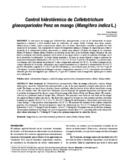| dc.contributor.author | Rondón, Olivier | |
| dc.contributor.author | Sanabria de Albarracín, Nelly | |
| dc.contributor.author | Rondón, Amado | |
| dc.date.accessioned | 2015-03-19T21:11:37Z | |
| dc.date.available | 2015-03-19T21:11:37Z | |
| dc.date.issued | 2006 | |
| dc.identifier | 471601 | es_ES |
| dc.identifier.issn | 1659-0082 | es_ES |
| dc.identifier.uri | https://repositorio.catie.ac.cr/handle/11554/5972 | |
| dc.description | 2 tabulaciones 13 referencias bibliográficas | es_ES |
| dc.description.abstract | La antracnosis del mango por Colletotrichum gloeosporioides es una de las enfermedades de mayor importancia económica a nivel mundial, tanto en condiciones de campo, donde el hongo ataca hojas, ramitas, inflorescencias y frutos, como en postcosecha, donde ataca los frutos almacenados causando la perdida del valor comercial de los mismos. Con el propósito de conocer la temperatura óptima y el tiempo de exposición para evitar el desarrollo de la enfermedad en frutos almacenados, se utilizó como material 140 frutos de mango de las variedades Haden (70 frutos) y Tommy Atkins (70 frutos), recolectadas en una finca al sur del Estado Aragua, Venezuela. La mayor inhibición del hongo se observó a temperaturas superiores a 45 °C, concordando con resultados obtenidos por otros investigadores que señalan 46,1 °C por 60-75 minutos como la temperatura óptima para el control de la enfermedad. | es_ES |
| dc.description.abstract | Mango anthracnosis, caused by Colletotrichum gloeosporioides, is one of the most important economic plant diseases in the world. The fungus can attack leaves, branches, flowers and fruits. After the harvest, it also affects stored fruits causing a loss of economic value. We carried out a laboratory essay to determine the optimum temperature and exposure time to avoid the development of the disease, using 140 kg of mango of the Haden (70 kg) and Tommy Atkins (70) varieties, collected at a plantation south of Aragua State, Venezuela. The maximum inhibition of the fungus was seen at temperatures of more than 45 °C, coinciding with results obtained by other authors indicating 46.1 °C during 60-75 min as the optimum temperature to control the disease. | en_EN |
| dc.format.mimetype | pdf | |
| dc.language.iso | es | es |
| dc.publisher | CATIE, Turrialba (Costa Rica) | es_ES |
| dc.relation.ispartof | Manejo Integrado de Plagas y Agroecología Número 78 (Agosto 2006) | |
| dc.rights.uri | https://creativecommons.org/licenses/by-nc-nd/4.0/ | |
| dc.subject | GLOMERELLA CINGULATA | es_ES |
| dc.subject | COLLETOTRICHUM | es_ES |
| dc.subject | FRUTO | es_ES |
| dc.subject | HONGOS | es_ES |
| dc.subject | ENFERMEDADES DE LAS PLANTAS | es_ES |
| dc.subject | ENFERMEDADES FUNGOSAS | es_ES |
| dc.subject | ENFERMEDADES POSTCOSECHA | es_ES |
| dc.subject | PLAGAS DE PRODUCTOS ALMACENADOS | es_ES |
| dc.subject | TRATAMIENTO TERMICO | es_ES |
| dc.subject | CONTROL DE PLAGAS (PROD ALM) | es_ES |
| dc.subject | CONTROL DE ENFERMEDADES | es_ES |
| dc.title | Control hidrotérmico de Colletotrichum gloeosporiodes Penz en mango (Mangifera indica L.) | es_ES |
| dc.title.alternative | Heat treatment of Colletotrichum gloeosporioides Penz in mango (Mangifera indica) | es_ES |
| dc.type | Artículo | es_ES |
| dc.journal.issueNumber | 78 | |
| dc.journal.pages | 76-79 | |



